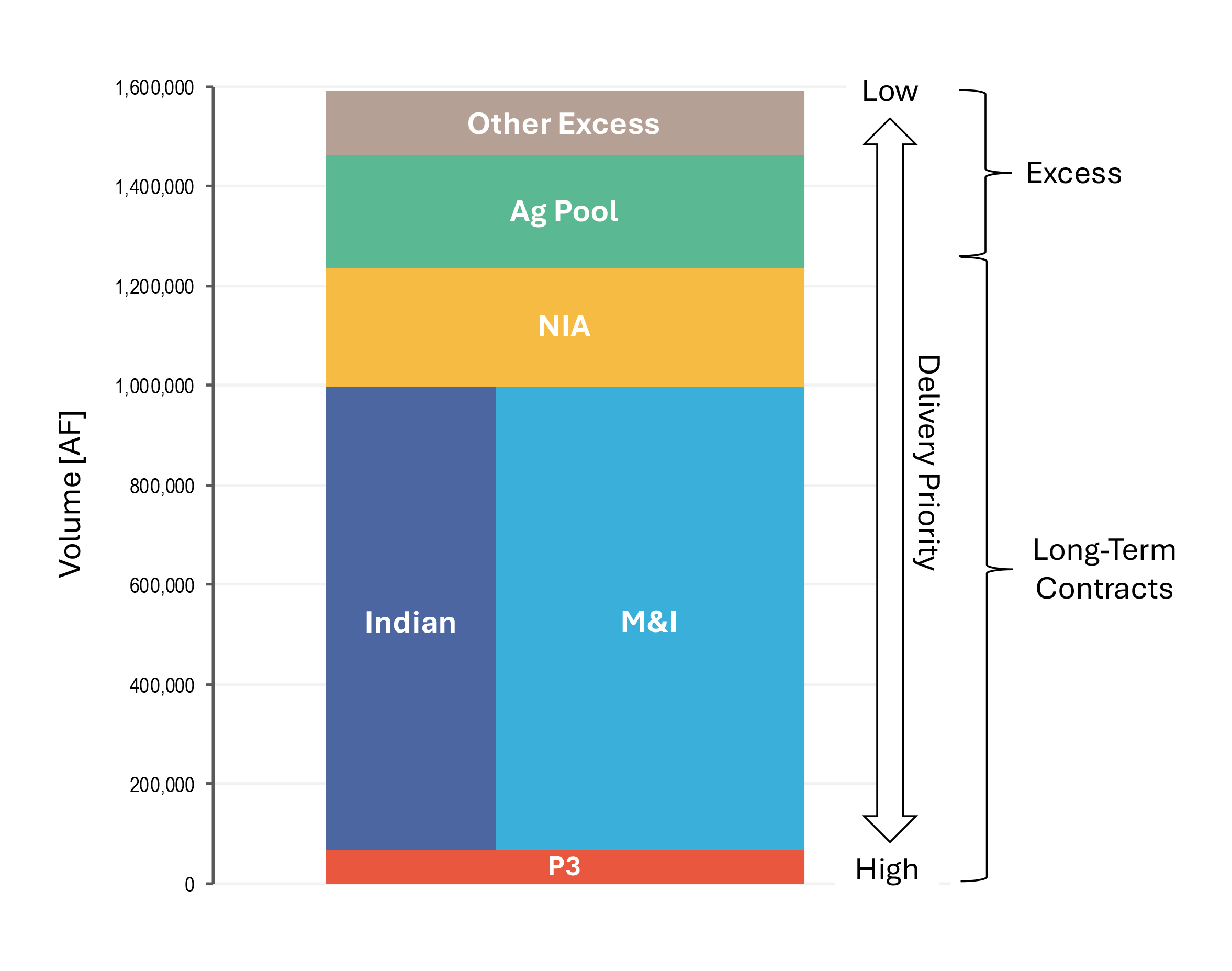
Curious about how the CAP Priority System works? Here’s your explainer.
If you’re a “water groupie” and find yourself at a lot of water-related meetings, the block chart to the right is likely familiar as a representation of CAP’s priority system
To fully understand the CAP priorities system, a brief history review is in order.
After authorization in 1968, CAP construction began in 1973. By the early 1980s, as the first part of construction was nearing completion, decisions were made regarding who would have long-term contract entitlements to CAP water. At that time, long-term contracts were split into three types – municipal and industrial (M&I), tribal and agricultural.
- M&I subcontracts were issued primarily based on projected future growth and consideration of existing supplies including other water supplies.
- Tribal contracts were the result of several federal decisions including Congressionally authorized water settlements.
- Irrigation districts were issued subcontracts for a percentage of the remaining available supply.
In the early years, it was assumed agriculture would take the largest portion of the available CAP supply as the other users grew into their entitlements. But once the water started flowing in 1985, reality set in and for many irrigation districts, CAP water was too expensive compared to pumping groundwater. The cost issues came to a head in the early 1990s, which led to a decade of litigation and negotiations, culminating in the 2004 Arizona Water Settlements Act and a reconfiguration of the CAP priority system.
The agricultural entitlements were relinquished by the irrigation districts and converted from percentage of supply to fixed volumes. In exchange for giving up their long-term rights, the irrigation districts were given access to a lower-cost fixed volume of even lower priority water.
The “Non-Indian Agricultural” (NIA) priority water was then allocated to tribes, cities and towns, and some was held back for future allocation. This term is a head-scratcher for many. But that’s because it relates to the lineage of the term – not to the way it’s used today. NIA refers to water that was originally designated for agriculture use, excluding tribes.
Now, back to the chart to the right …
The first thing to note is the “up/down” arrow on the right-hand side with “low” on the top and “high” on the bottom. That means that in this chart, you want to be closer to the bottom, rather than to the top!
So, we’ll go over the chart from the bottom-up:
Long-term contracts
P3 – This is a small portion of the highest-priority water, termed Third Priority (P3). It shares priority with some of the large irrigation districts in Yuma and elsewhere on the mainstem of the Colorado River.
Indian and M&I – Combined, these pools make up the majority of CAP’s long-term contracts. These pools are depicted side-by-side because they are roughly co-equal in priority. There is also some cross-over in use of these supplies, as some tribes lease water to cities.
NIA – This is the Non-Indian Agricultural pool, referenced above, primarily available to cities, industries and tribes.
Excess Water
Ag Pool – Any water available to CAP after satisfying the long-term contracts is termed “Excess Water” and the agricultural districts that gave up their long-term contracts have first access to it.
Other Excess – Any Excess Water available after satisfying the Ag Pool is classified as Other Excess and historically has primarily been used by the Arizona Water Banking Authority and the Central Arizona Groundwater Replenishment District for underground storage.
Why does the CAP Priority System matter?
There are some differences in cost and other provisions among the priorities, but most importantly, the priorities determine water availability during times of shortage.
Since 2020, CAP has been taking mandatory Colorado River reductions, most typically in the Tier 1 category. Currently, that represents a 512,000-acre foot reduction to Arizona’s Colorado River supply, constituting about 30% of CAP’s normal supply. In terms of priorities, this equates to the elimination of the Other Excess and Ag Pools, increasingly significant cuts into the NIA Pool and a very small amount of cuts into the M&I and Tribal pools.



